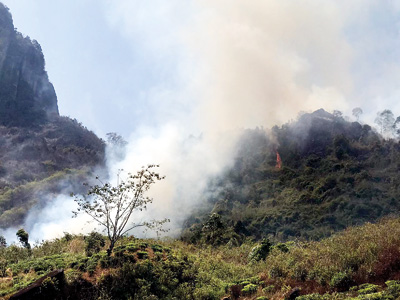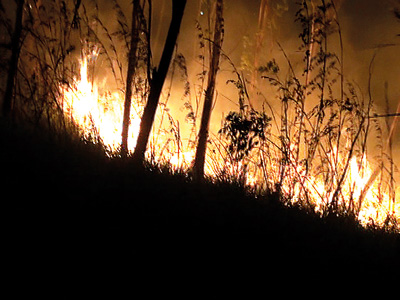News
Fighting fire with fire
With concern mounting over the increasing number of manmade forest fires, experts stress the importance of effective community level awareness and participation — turning known fire-setters in villages into firefighters
Sri Lanka has seen a sharp rise in manmade fires this year–with 129 reported since January alone–and there are fears of more blazes in the crackling dry weeks ahead.

Singhimale reserve in Hatton: In just Hatton, there have been 30 fires with a total damage of 118.5 hectares
Fifty-five of these fires were in Forest Department reserves and destroyed around 200 hectares. Officials and conservationists expressed frustration saying the disasters were entirely preventable.
People cooking outdoors or throwing out cigarette butts were the main causes of the recent fires, said Nishantha Edirisinghe, Conservator of Forests. Nuwara Eliya, Badulla, Kegalle and Galle (in that order) had the highest number of blazes this year, statistics show.
In just Hatton, there have been 30 fires with a total damage of 118.5 hectares, said Divisional Forest Officer Sujith Ajantha. The most common reasons there for setting forests alight were to facilitate hunting, to grow pastures for grazing, for “fun” and over a traditional belief that starting such fires caused the formation of rainclouds. This was a common practice among plantation workers.
The Disaster Management Centre (DMC) has been collating data on the fires. They counted 129 fires, including three in garbage dumps, upto March 4. The District DMCs play a coordinating role, sending relevant resources to hotspots including military helicopters, tri-forces, police, fire brigade and Forest or Wildlife Conservation Department (WCD) officials.
The Air Force said it deployed chopper assistance eight times this year, starting on February 13. Deemed serious, these fires occurred in Singhimale (Hatton), Ambalamulla garbage dump in Seeduwa, the Buthgamuwa garbage dump in Rajagiriya, Nallathanni (Hatton), again in Singhimale, and twice in the Narangala Forest in Giriulla. The last blazes on March 3 and 4 required a total of 35 “Bambi” or helicopter buckets–or 33,250 litres of water–to douse them.
The DMC “needs better touch on the ground,” said Jayantha Wijesinghe, Rainforest Protectors of Sri Lanka Convener. But he admitted that, under its new leadership, the Centre has been communicating better with organisations like his. Sri Lanka loses around 6,000 forest acres to fires every year.
“In these emergencies, the fastest action can come from the immediate community, so we need to empower them,” he said, pointing to a successful firefighting project they implemented in Rakwana.
The organisation brought together a group of community firefighters led by known fire-setters in the village to douse any sudden flames. Making suspected perpetrators their own watchmen proved to be a simple yet effective solution, Mr Wijesinghe claimed, adding that the Rakwana Hills in East Sinharaja have not had a fire since 2016.
The law prescribes fines of between Rs 20,000 and 200,000 and up to seven years in prison for starting a fire in a conserved forest; a fine of between Rs 10,000 and 100,000 and up to five years in jail for starting a fire in a reserved forest; and a fine of between Rs 5,000 and 50,000 and a sentence of up to two years in prison for any other lands. But the judicial route has proved futile as the miscreants cannot be identified.
Last year, there were 171 fires in Forest Department lands, destroying 1,068 hectares, Mr Nishantha said. He said public awareness was one of the most important aspects of prevention. This is being done in collaboration with Divisional Secretariats, the tri-forces, estate companies and DDMCs, with particular focus on plantation workers of Nuwara Eliya and Badulla. Poster campaigns and door-to-door visits were included.
There were also “shramadanas” to clear forest areas of anything that could fuel blazes. A programme on February 18 in Nuwara Eliya saw the participation of more than 600 people. The construction of fire belts was also viable but expensive, costing around Rs 150,000 a kilometre. This is a gap in vegetation that acts as a barrier to slow or stop the progress of a bushfire or wildfire.

Badulla burns: Next to Nuwara Eliya Badulla had the highest number of blazes this year. Pic by Palitha Ariyawansa
“Control burning”–the practice of burning the fuel accumulated on forest floors–is practiced in many countries but not possible in Sri Lanka owing to the vast quantities of flora and fauna species in the undergrowth, said a Forest Department official.
The easy access arsonists have to vulnerable forests is a key cause for concern. “Since it doesn’t take much to start a fire, most perpetrators are long gone by the time it gets going,” said a WCD official.
Information is a crucial important resource, said Mr Wijesinghe. “If we know what the hotspots in forests are, what their seasons are, who the people that are usually setting these fires off and why they do it, preventing them should be easier,” he said. Most Grama Niladharis knew these details as they had hands-on experience among the local community.
A dire shortage of staff and offices is crippling to both the Forest Department and WCD. There was only one WCD office based in Mirissa for the entire Matara district, to cover 310 hectares under its purview. It was essential to have another branch inside the “Kirala Kee” Sanctuary where a fire occurred recently, said Damith Chandana Mahanama an Assistant Ranger at the Mirissa office.

